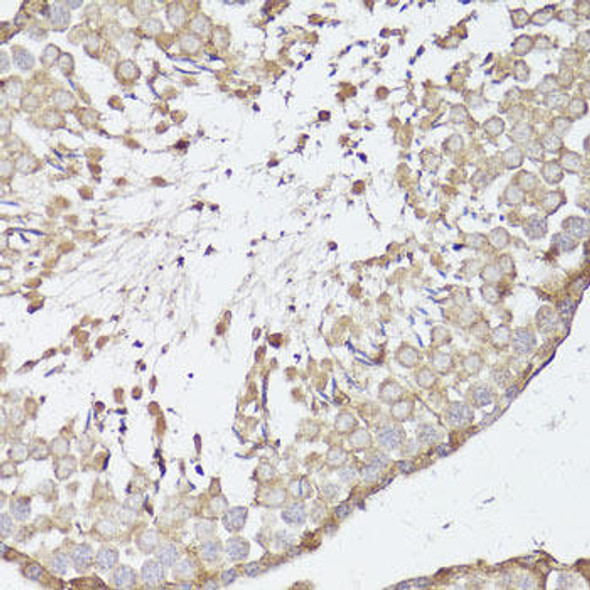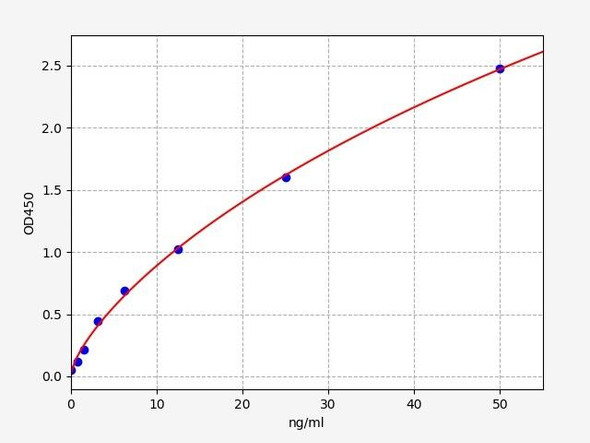Developmental Biology
Anti-OPRK1 Antibody (CAB8306)
- SKU:
- CAB8306
- Product Type:
- Antibody
- Applications:
- WB
- Reactivity:
- Human
- Reactivity:
- Mouse
- Reactivity:
- Rat
- Host Species:
- Rabbit
- Isotype:
- IgG
- Research Area:
- Developmental Biology
Description
| Antibody Name: | OPRK1 Rabbit Polyclonal Antibody |
| Antibody SKU: | CAB8306 |
| Antibody Size: | 20uL, 50uL, 100uL |
| Application: | WB |
| Reactivity: | Human, Mouse, Rat |
| Host Species: | Rabbit |
| Immunogen: | Recombinant fusion protein containing a sequence corresponding to amino acids 1-60 of human OPRK1 (NP_000903.2). |
| Application: | WB |
| Recommended Dilution: | WB 1:500 - 1:2000 |
| Reactivity: | Human, Mouse, Rat |
| Positive Samples: | U-251MG, HeLa, U-937, Mouse brain, Rat brain |
| Immunogen: | Recombinant fusion protein containing a sequence corresponding to amino acids 1-60 of human OPRK1 (NP_000903.2). |
| Purification Method: | Affinity purification |
| Storage Buffer: | Store at -20'C. Avoid freeze / thaw cycles. Buffer: PBS with 0.02% sodium azide, 50% glycerol, pH7.3. |
| Isotype: | IgG |
| Sequence: | MDSP IQIF RGEP GPTC APSA CLPP NSSA WFPG WAEP DSNG SAGS EDAQ LEPA HISP AIPV |
| Gene ID: | 4986 |
| Uniprot: | P41145 |
| Cellular Location: | Cell membrane, Multi-pass membrane protein |
| Calculated MW: | 33kDa/42kDa |
| Observed MW: | 43kDa |
| Synonyms: | OPRK1, K-OR-1, KOR, KOR-1, OPRK |
| Background: | This gene encodes an opioid receptor, which is a member of the 7 transmembrane-spanning G protein-coupled receptor family. It functions as a receptor for endogenous ligands, as well as a receptor for various synthetic opioids. Ligand binding results in inhibition of adenylate cyclase activity and neurotransmitter release. This opioid receptor plays a role in the perception of pain and mediating the hypolocomotor, analgesic and aversive actions of synthetic opioids. Variations in this gene have also been associated with alcohol dependence and opiate addiction. Alternatively spliced transcript variants encoding different isoforms have been found for this gene. A recent study provided evidence for translational readthrough in this gene and expression of an additional C-terminally extended isoform via the use of an alternative in-frame translation termination codon. |
| UniProt Protein Function: | KOR-1: kappa-type opioid receptor. Inhibits neurotransmitter release by reducing calcium ion currents and increasing potassium ion conductance. Receptor for dynorphins. May play a role in arousal and regulation of autonomic and neuroendocrine functions. |
| UniProt Protein Details: | Protein type:Receptor, GPCR; Membrane protein, multi-pass; Membrane protein, integral; GPCR, family 1 Chromosomal Location of Human Ortholog: 8q11.2 Cellular Component: dendrite; integral to membrane; integral to plasma membrane; nerve terminal; neuron projection; perikaryon; plasma membrane; synapse Molecular Function:neuropeptide binding; opioid receptor activity; protein binding Biological Process: behavior; behavioral response to cocaine; defense response to virus; eating behavior; G-protein signaling, adenylate cyclase inhibiting pathway; G-protein signaling, coupled to IP3 second messenger (phospholipase C activating); immune response; locomotory behavior; maternal behavior; negative regulation of luteinizing hormone secretion; neuropeptide signaling pathway; opioid receptor, adenylate cyclase inhibiting pathway; positive regulation of dopamine secretion; positive regulation of locomotion; regulation of saliva secretion; regulation of sensory perception of pain; response to estrogen stimulus; response to ethanol; response to insulin stimulus; response to morphine; response to radiation; sensory perception; sensory perception of pain; sensory perception of temperature stimulus; synaptic transmission |
| NCBI Summary: | This gene encodes an opioid receptor, which is a member of the 7 transmembrane-spanning G protein-coupled receptor family. It functions as a receptor for endogenous ligands, as well as a receptor for various synthetic opioids. Ligand binding results in inhibition of adenylate cyclase activity and neurotransmitter release. This opioid receptor plays a role in the perception of pain and mediating the hypolocomotor, analgesic and aversive actions of synthetic opioids. Variations in this gene have also been associated with alcohol dependence and opiate addiction. Alternatively spliced transcript variants encoding different isoforms have been found for this gene. A recent study provided evidence for translational readthrough in this gene and expression of an additional C-terminally extended isoform via the use of an alternative in-frame translation termination codon. [provided by RefSeq, Jan 2016] |
| UniProt Code: | P41145 |
| NCBI GenInfo Identifier: | 116242691 |
| NCBI Gene ID: | 4986 |
| NCBI Accession: | P41145.2 |
| UniProt Secondary Accession: | P41145,Q499G4, E5RHC9, |
| UniProt Related Accession: | P41145 |
| Molecular Weight: | 33,319 Da |
| NCBI Full Name: | Kappa-type opioid receptor |
| NCBI Synonym Full Names: | opioid receptor kappa 1 |
| NCBI Official Symbol: | OPRK1 |
| NCBI Official Synonym Symbols: | KOR; OPRK; KOR-1; K-OR-1 |
| NCBI Protein Information: | kappa-type opioid receptor |
| UniProt Protein Name: | Kappa-type opioid receptor |
| Protein Family: | Kappa-type opioid receptor |
| UniProt Gene Name: | OPRK1 |
| UniProt Entry Name: | OPRK_HUMAN |







